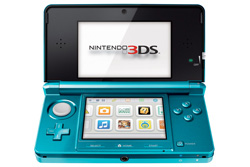Europe's online source of news, data & analysis for professionals involved in packaged media and new delivery technologies

Nintendo 3DS brings 3D autosteroscopic immersion to gaming
Nintendo has launched its new handheld game consoler, 3DS. It offers users 3D glasses-free autosteoscopic viewing to generally positive review, as nobody knew what immersive effect to expect on such a platform.
“The depth effect tricks your mind so well that objects appear corporeal, as if you could reach in and pluck them out,” writes one reviewer who tested the console. “However, the 3D effect fails spectacularly when shoulder surfing. 3D is visible only with the device held directly in front, appearing at around 20cm and, optimally, between 30cm and 50cm.”
The rigid location where users need to stand for optimised 3D immersive effect is an issue that plagues most of the 3D glasses-free TV systems on offer.
“Too close and your eyes lose focus, too far and depth becomes increasingly indiscernible. Move your head 5cm to either side, or rotate the device through a mere five degrees, and dark smudging streaks across the screen. Fortunately, the sweet spot is exactly where you need it, well within the bounds of comfortable handheld use.”
Of interest is that the user can control the depth of 3D via a slider to fine-tune the effect to suit individual eyesight, viewing distance and specific applications. The slider also turns off 3D entirely.
Limited as these in-built games are, they offer promising glimpses into the future of Augmented Reality. For example, the game Face Raiders combines the built-in cameras and gyroscopic sensors into a novel kinetic game. After posing for a snapshot, the user’s face is overlaid on 3D helmets, which are superimposed onto the real world through the viewfinder.
The reviewer concludes that the 3DS console “provides the most compelling evidence to date that 3D can enhance gameplay, not just beautify it.”
Story filed 27.03.11




















